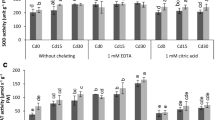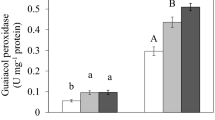Abstract
Root growth of the seedlings of maize cultivars Premia and Blitz exposed to 2 μM cadmium (Cd), nickel (Ni) or both metals acting simultaneously (Cd + Ni) for 72 h was significantly reduced but not ceased. The effect was more pronounced in the seedlings of the cv. Blitz. The heavy metals (HMs) contents increased significantly in the roots. Simultaneous application of metals had an antagonistic effect on either Cd or Ni uptake in Premia but not in Blitz. In control roots the contents of ascorbic acid (AsA) and dehydroascorbic acid (DHA) were lower and gluthatione (GSH) content was higher in Premia than in Blitz. A decrease of AsA content was induced by all metal treatments in Premia but only by Cd + Ni in Blitz while an increase was induced by single metals in this cultivar. All metal treatments increased DHA contents in both cultivars. GSH content decreased significantly in Premia treated with Cd or Cd + Ni, and in Blitz treated with Ni. Unlike the contents of AsA, DHA and GSH, the increased metal concentrations in root cells did not affect the membrane potential (E M). The changes in antioxidant contents depended on both, maize genotypes and HMs treatments. Nevertheless, the results indicated a role of antioxidative system in minimizing the effects of oxidative stress and protecting cell membranes in both maize cultivars.
Similar content being viewed by others
References
Angelova V., Ivanova R., Delibaltova V. & Ivanov K. 2004. Bioaccumulation and distribution of heavy metals in fiber crops (flax, cotton and hemp). Ind. Crop. Prod. 19: 197–205.
Arrigoni O. & De Tullio M.C. 2000. The role of ascorbic acid in cell metabolism: between gene-directed functions and unpredictable chemical reactions. J. Plant Physiol. 157: 481–488.
Arvind P. & Prasad M.N.V. 2005. Modulation of cadmiuminduced oxidative stress in Ceratophyllum demersum by zinc involves ascorbate-glutathione cycle and glutathione metabolism. Plant Physiol. Biochem. 43: 107–116.
Baccouch S., Chaoui A. & Ferjani E. 2001. Nickel toxicity induces oxidative damage in Zea mays roots. J. Plant Nutr. 24: 1085–1097.
Bai C., Reilly C.C. & Wood B.W. 2006. Nickel deficiency disrupts metabolism of ureides, amino acids, and organic acids of young pecan foliage. Plant Physiol. 140: 433–443.
Belimov A.A., Safronova V.I., Tsyganov V.E., Borisov A.Y., Tikhonovich I.A., Soboleva V.N., Kvokova N.A., Zaitseva L.N., Poddubnykh O.N., Dolgaya L.N. & Sukhanov P.A. 1999. Screening of garden pea varieties by their resistance to cadmium and accumulation of heavy metals. Pisum Genetics 31: 39–40.
Beutler E., Duran O. & Kelly B.U. 1963. The definition of glutathione in blood. J. Lab. Chim. Med. 61: 882–886.
Borzou A. & Azizinezhad F. 2012. Investigation of lettuce pollution with cadmium and lead in Varamin region in Iran. J. Pharm. Biol. Chem. Soc. 3: 317–324.
De Pinto M.C., Francis D. & De Gara L. 1999. The redox state of the ascorbate-dehydroascorbate pair as a specific sensor of cell division in tobacco BY2 cells. Protoplasma 209: 90–97.
Ekmekçi Y., Tanyolac D., Ayhan B. 2008. Effects of cadmium on antioxidant enzyme and photosynthetic activities in leaves of two maize cultivars. J. Plant Physiol. 165: 600–611.
Fiala R., Kenderešová L., Syshchykov D.V., Martinka M., Repka V., Pavlovkin J. & Čiamporová M. 2013. Comparison of root growth and morphological responses to cadmium and nickel in two maize cultivars. Modern Phytomorphology 3: 131–137.
Freeman J.L., Persans M.W., Nieman K., Albrecht C., Peer W., Pickering I.J. & Salta D.E. 2004. Increased glutathione biosynthesis plays a role in nickel tolerance in Thlaspi nickel hyperaccumulators. Plant Cell 16: 2176–2191.
Gajewska, E. & Skłodowska M. 2008. Differential biochemical responses of wheat shoots and roots to nickel stress: antioxidative reactions and proline accumulation. Plant Growth. Regul. 54: 179–188.
Gallie D.R. 2013. L-Ascorbic Acid: A multifunctional molecule supporting plant growth and development. Scientifica, Article ID 795964, 24 pages, http://dx.doi.org/10.1155/2013/795964.
Gryshko V.N. & Syshchykov D.V. 2002. Method for determination of glutathione reduced form in plant vegetative organs. Ukr. Biochem. J. 74: 123–124.
Huang G.Y., Wang Y.S., Sun C.C., Dong J.D. & Sun Z.X. 2010. The effect of multiple heavy metals on ascorbate, glutathione and related enzymes in two mangrove plant seedlings (Kandelia candel and Bruguiera gymnorrhiza). Int. J. Oceanograph. Hydrobiol. 39: 11–25.
Janicka-Russak M., Kabała K., Burzyński M. & Kłobus G. 2008. Response of plasma membrane H+ -ATPase to heavy metal stress in Cucumis sativus roots. J. Exp. Bot. 59: 3721–3728.
Jocsak I., Vegvari G., Rabnecz G. & Droppa M. 2008. Investigation of nickel stress induction in terms of metal accumulation and antioxidative enzyme activity in barley seedlings. Acta Biol. Hung. 52: 167–71.
Kampfenkel K., van Montagu M. & Inzč D. 1995. Extraction and determination of ascorbate and dehydroascorbate from plant tissue. Anal. Biochem. 225: 165–167.
Kumar H., Sharma D. & Kumar V. 2012. Nickel-induced oxidative stress and role of antioxidant defense in barley roots and leaves. Int. J. Env. Biol. 2: 121–128.
L’Huiller L., d’Auzac J., Durand M. & Michaud-Ferriere N. 1996. Nickel effects on two maize (Zea mays) cultivars: Growth, structure, Ni concentration, and localization. Can. J. Bot. 74: 1547–1554.
Liu Y.G., Wang X., Zeng G.M., Qu D., Gu J.J., Zhou M. & Chai L. 2007. Cadmium-induced oxidative stress and response of the ascorbate-glutathione cycle in Bechmeria nivea (L.). Chemosphere 69: 99–107.
Maysa M.H. & Abdel-Aal E.A. 2008. Oxidative stress and antioxidant defense mechanisms in response to cadmium treatment. Am. Eur. J. Agric. Environ. Sci. 4: 655–669.
Meuwly P. & Rauser V. 1992. Alteration of thiol pools in roots and shoots of maize seedlings exposed to cadmium. Plant Physiol. 99: 8–15.
Paradiso A., Berardino R., De Pinto M.C., Sanità di Toppi L., Storelli M.M., Tommasi F. & De Gara L. 2008. Increase in ascorbate-gluthatione metabolism as local and precocious systemic responses induced by cadmium in durum wheat plants. Plant Cell Physiol. 49: 362–374.
Pavlovkin J., Luxová M., Mistríková I. & Mistrík I. 2006. Shortand long-term effects of cadmium on transmembrane electric potential (Em) in maize roots. Biologia 61: 109–114.
Rao K.V.M. & Sresty T.V. 2000. Antioxidative parameters in the seedlings of pigeonpea (Cajanus cajan (L.) Millspaugh) in response to Zn and Ni stresses. Plant Sci. 157: 113–128.
Rauser W.E. & Meuwly P. 1995. Retention of cadmium in roots of maize seedlings. Plant Physiol. 109: 195–202.
Reeves R.D. & Baker A.J.M. 2000. Metal-accumulating plants, pp. 193–229. In: Raskin I. & Ensley B.D. (eds), Phytoremediation of toxic metals: Using plants to clean up the environment. John Wiley and Sons, London.
Rellán-Álvarez R., Ortega-Villasante C., Álvarez-Fernandez A., del Campo F.F. & Hernández L.E. 2006. Stress responses of Zea mays to cadmium and mercury. Plant Soil 279: 41–50.
Rivera-Becerril F., Calantzis C., Turnau K., Caussanel J-P., Belimov A.A., Gianinazzi S., Strasser J.R. & Gianinazzi-Pearson V. 2002. Cadmium accumulation and buffering of cadmium-induced stress by arbuscular mycorrhiza in three Pisum sativum L. genotypes. J. Exp. Bot. 53: 1177–1185.
Rodriguez-Serrano M., Romero-Puertas M.C., Zabalza A., Corpas F.J., Gomez M., Del Rio L.A. & Sandalio L.M. 2006. Cadmium effect on oxidative metabolism of pea (Pisum sativum L.) roots. Imaging of reactive oxygen species and nitric oxide accumulation in vivo. Plant Cell. Env. 29: 1532–1544.
Sanz A., Llamas A. & Ullrich C.I. 2009. Distinctive effects of Cd and Ni on membrane functionality. Plant Signal. Behav. 4: 4980–4998.
Schützendübel A. & Polle A. 2002. Plant responses to abiotic stresses: heavy metal-induced oxidative stress and protection by mycorrhization. J. Exp. Bot. 53: 1351–1365.
Seregin I.V. & Kozhevnikova A.D. 2006. Physiological role of nickel and its toxic effects on higher plants. Russ. J. Plant Physiol. 53: 257–277.
Sharma S.S. & Dietz K. 2009. The relationship between metal toxicity and cellular redox imbalance. Trends Plant Sci. 14: 43–50.
Široká B., Huttová J., Tamás L., Šimonovičová M. & Mistrík I. 2004. Effect of cadmium on hydrolytic enzymes in maize root and coleoptile. Biologia 59: 513–517.
Tran T.A. & Popova L.P. 2013. Functions and toxicity of cadmium in plants: recent advances and future prospects. Turk. J. Bot. 37: 1–13.
Wang M., Zou J., Duan X., Jiang W. & Liu D. 2007. Cadmium accumulation and its effects on metal uptake in maize (Zea mays L.). Bioresource Technol. 98: 82–88.
Yadav S.K. 2010. Heavy metals toxicity in plants: An overview on the role of glutathione and phytochelatins in heavy metal stress tolerance of plants. S. Afr. J. Bot. 76: 167–179.
Author information
Authors and Affiliations
Corresponding author
Rights and permissions
About this article
Cite this article
Artiushenko, T., Syshchykov, D., Gryshko, V. et al. Metal uptake, antioxidant status and membrane potential in maize roots exposed to cadmium and nickel. Biologia 69, 1142–1147 (2014). https://doi.org/10.2478/s11756-014-0414-4
Received:
Accepted:
Published:
Issue Date:
DOI: https://doi.org/10.2478/s11756-014-0414-4




